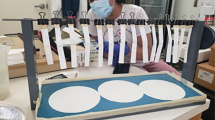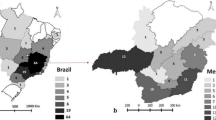Abstract
The current work evaluated the efficacy of 10 commercial acaricides in different pHs (4.5, 5.5, and 6.5) in laboratory (adult immersion tests (AIT), pH evaluation over time) and field assays (tick counts and efficacy). In the AIT (n=70), higher efficacies were obtained when the acaricide emulsion had a more acidic pH (4.5), mainly for two combinations of pyrethroids + organophosphate (acaricide 3 and acaricide 9). For amidine, a higher pH (6.5) showed a higher efficacy. Over time, there was a trend in the pH of these emulsions increasing. When the efficacy of chlorpyrifos + cypermethrin + piperonyl butoxide (acaricide 3) at different pHs was evaluated over time (0, 6, 12, and 24h) by AIT, the less acidic pH (6.5) showed a strongly variation in the acaricide efficacy range. The mean pH of the water samples from different regions of Brazil was 6.5. In the field, the association of pyrethroid + organophosphates (acaricide 9) with pH of 4.5 and 5.5 were more effective in tick control than the emulsion prepared with this same spray formulation at pH 6.5. The pH of the acaricide emulsions is an important point of attention and is recommended that the veterinary industry start to develop/share information regarding how the pH can affect the acaricide efficacy.



Similar content being viewed by others
Data availability
The datasets generated during and/or analyzed during the current study are available from the corresponding author on reasonable request.
References
Brazil (1997) Ministério da Agricultura e Abastecimento, Secretaria de Defesa Agropecuária, Portaria n.°48. https://www.gov.br/agricultura/pt-br/assuntos/insumos-agropecuarios/insumos-pecuarios/produtos-veterinarios/legislacao-1/portaria/portaria-sda-mapa-no-48-de-12-05-1997.pdf/view. Accessed 5 Oct 2022
Corta E, Bakkali A, Berrueta LA, Gallo B, Vicente F (1999) Kinetics and mechanism of amitraz hydrolysis in aqueous media by HPLC and GC-MS. Talanta 48:189–199. https://doi.org/10.1016/s0039-9140(98)00237-9
Cruz BC, Mendes AFL, Maciel WG, Santos IB, Gomes LVC, Felippelli G, Teixeira WFP, Ferreira LL, Soares VE, Lopes WDZ, Costa AJ, Oliveira GP (2020) Biological parameters for Rhipicephalus microplus in the field and laboratory and estimation of its annual number of generations in a tropical region. Parasitol Res 119:2421–2430. https://doi.org/10.1007/s00436-020-06758-5
Davey RB, Ahrens EH, George JE, Karns JS (1995) Efficacy of freshly mixed coumaphos suspensions adjusted to various pH levels for treatment of cattle infested with Boophilus annulatus (Say) (Acari: Ixodidae). Prev Vet Med 23:1–8. https://doi.org/10.2460/ajvr.2003.64.684
De Putter H, Adiyoga W, Schepers HTAM, Topper C (2017) VegIMPACT Report 42. Netherlands Government, p 38
Drummond RO, Ernst SE, Trevino JL, Gladney WJ, Graham OH (1973) Boophilus annulatus and B. microplus: laboratory tests of insecticides. J Econ Entomol 66:130–133. https://doi.org/10.1093/jee/66.1.130
FAO - Food and Agriculture Organization of the United Nations (2004) Resistance management and integrated parasite control in ruminants: guidelines. In: Module 1. Ticks: Acaricide Resistance: Diagnosis, Management and Prevention, pp 25–77. ftp://ftp.fao.org/docrep/fao/010/ag014e/ag014e05.pdf. Accessed 5 Oct 2022
Fishel FM, Ferrell JA (2019) Water pH and the effectiveness of pesticides. IFAS Extension. University of Florida. PI-156, pp 1–3
George JE, Davey RB, Ahrens EH, Pound JM, Drummond RO (1998) Efficacy of amitraz (Taktic 12.5% EC) as a dip for the control of Boophilus microplus (Canestrini) (Acari: Ixodidae) on cattle. Prev Vet Med 37:55–67. https://doi.org/10.1016/s0167-5877(98)00098-1
Graf JF, Gogolewski R, Leach-Bing N, Sabatini GA, Molento MB, Bordin EL, Arantes GJ (2004) Tick control: an industry point of view. Parasitol 129:S427–S442. https://doi.org/10.1017/s0031182004006079
Hock WK (1994) Effect of pH on pesticide stability and efficacy. Georgia Floriculture, pp 24–25
International Atomic Energy Agency – FAO/IAEA, 1996. Research and development on procedures to stabilize acaricides in livestock dips. Ottawa, Cana, pp. 6-10. https://www.iaea.org/publications/5638/research-and-development-on-procedures-to-stabilize-acaricides-in-livestock-dips
Jindal T, Singh DK, Agarwal HC (2002) Persistence and degradation of coumaphos in model cattle dipping vats. J Environ Sci Health B 37:33–42. https://doi.org/10.1081/PFC-120002895
Karns JF, Ahrens EH, Davey RB (1997) Preservation of coumaphos in cattle dipping vats. SouthWesteern Entomologist 22:307–314
Kkadan SK, Duran A, Wijaya R, Sinulingga NGH, Tavares WS, Tarigan M, Wong CY, Sharma M (2020). Impact of water quality on insecticide efficacy. Special feature: pest of crop & amenity trees https://www.researchgate.net/publication/348992582_Impact_of_water_quality_on_insecticide_efficacy. Accessed 26 Aug 2022
Lamboy JS (2000) Alkaline degradation of pesticides. New York State Integrated Pest Management Program, Cornell University. Online publications, New York http://www.nysipm.cornell.edu/
Lukić M, Pantelić I, Savić SD (2021) Towards optimal pH of the skin and topical formulations: from the current state of the art to tailored products. Cosmetics 8:69. https://doi.org/10.3390/cosmetics8030069
Malek MA, Rahman MM, Amin MR (1997) Stability of lindane, chlorpyrifos and coumaphos in model cattle dip. Journal of Agricultural and Food Chemistry, Washington 45:3279–3282 publications/alk.deg.html
Rodriguez-Vivas RI, Jonsson NN, Bhushan C (2018) Strategies for the control of Rhipicephalus microplus ticks in a world of conventional acaricide and macrocyclic lactone resistance. Parasitol Res 117:3–29. https://doi.org/10.1007/s00436-017-5677-6
Roulston WJ, Wharton RH, Nolam J, Kevr JD (1968) Acaricide tests on the Biarra strain of organophosphorus resistant cattle ticks Boophilus microplus from southern Queensland. Aust Vet J 43:129–134. https://doi.org/10.1111/j.1751-0813.1967.tb08916.x
Taylor MA (2001) Recent developments in ectoparasiticides. Vet J 161:253–268. https://doi.org/10.1053/tvjl.2000.0549
Tharp C (2013) Pesticide performance and water quality. Agriculture and Natural Tesources (Pesticides). Montana State University (MSU Extension), p 1213SA. https://doi.org/10.3390/ijerph18031112
Weiner RF, Matthews RA (2003) Measurement of water quality. In: Environmental engineering, 4th edn. Butterworth-Heinemann, United States of America, pp 81–106
Wharton RH, Utech KBW (1970) Relation between engorgement and dropping of Boophilus microplus to assessment of tick number in cattle. Aust Entomol Soc 9:171–182
Whitford F, Penner D, Johnson B, Bledsoe L, Wagoner N, Garr J, Wise K, Oberneyer J, Blessing A (2016) The impact of water quality on pesticide performance. Purdue University Extension. https://www.extension.purdue.edu/extmedia/ppp/ppp-86.pdf. Accessed 5 Oct 2022
Yousefi H, Su HM, Imani SM, Alkhaldi K, Filipe CD, Didar TF (2019) Intelligent food packaging: a review of smart sensing technologies for monitoring food quality. ACS Sens 4:808–821. https://doi.org/10.1021/acssensors.9b00440
Funding
Partial financial support was received from the Coordenação de Aperfeiçoamento de Pessoal de Nível Superior (CAPES), Brazil—funding code 001.
Author information
Authors and Affiliations
Contributions
João Eduardo Nicaretta: investigation; data curation, data interpretation; Lorena Lopes Ferreira: data interpretation, writing—original draft, review, and editing; Alliny Souza Assis Cavalcante: investigation; Dina María Beltrán Zapa: investigation; Luciana Maffini Heller: investigation; Artur Siqueira Nunes Trindade: investigation; Igor Maciel Lopes de Morais: investigation; Vanessa Ferreira Salvador; investigation; Luccas Lourenzzo Lima Lins Leal: investigation; Francisca Letícia Vale da Silva: investigation, data curation, data interpretation; Lídia Mendes de Aquino: investigation; Luiz Fellipe Monteiro Couto: investigation; Vando Edésio Soares: formal analysis; Caio Márcio Oliveira Monteiro: methodology, data interpretation, writing—review and editing; Welber Daniel Zanetti Lopes: supervision, conceptualization, methodology, data curation, data interpretation, writing—review and editing. All authors read and approved the final manuscript.
Corresponding author
Ethics declarations
Ethics approval
The project was approved by the Ethics Committee on the Use of Animals (CEUA) of the Federal University of Goiás (UFG) (Protocol 072/18), being in accordance with ethical principles in animal experimentation.
Consent to participate
The authors obtained consent from the responsible authorities at the institute/organization where the work has been carried out before the work is submitted.
Consent for publication
All authors gave explicit consent to submit the work.
Competing interests
The authors declare no competing interests.
Additional information
Section Editor: Van Lun Low
Publisher’s note
Springer Nature remains neutral with regard to jurisdictional claims in published maps and institutional affiliations.
Rights and permissions
Springer Nature or its licensor (e.g. a society or other partner) holds exclusive rights to this article under a publishing agreement with the author(s) or other rightsholder(s); author self-archiving of the accepted manuscript version of this article is solely governed by the terms of such publishing agreement and applicable law.
About this article
Cite this article
Nicaretta, J.E., Ferreira, L.L., de Cavalcante, A.S. et al. Influence of the acaricide emulsion pH on the effectiveness of spray products to control the cattle tick: laboratory and field investigations. Parasitol Res 122, 2267–2278 (2023). https://doi.org/10.1007/s00436-023-07927-y
Received:
Accepted:
Published:
Issue Date:
DOI: https://doi.org/10.1007/s00436-023-07927-y




